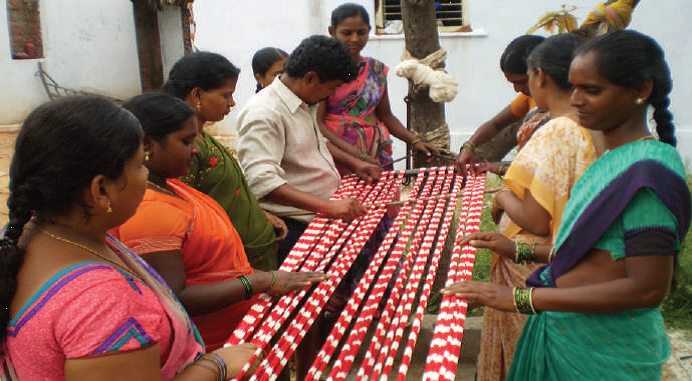Weaves to dye for
Weaves to dye for
India is a vast, diverse country with a rich tradition of weaving. Ikkat is a dyeing technique used to pattern textiles that employs resist dyeing on the yarns prior to dyeing and weaving the fabric. Weaving ikkat was a household activity in Telangana in early days. However, with younger generation taking up other employment / migration, in Nalgonda district each family was left with 1 or 2 members taking up the activity. To make the activity lucrative, interventions were required for better designs, skill and technology upgradation and market development to provide sustainable livelihood.
Activity
Weaving ikkat fabric in Nalgonda Dist., Telangana
Nature of Intervention
At a total project cost of Rs.3.93 lakh under LEDP of NABARD, 90 rural SHG women in the age group of 18 to 45, mostly belonging to weaver families of Nemmani, Mandra and Vellanky villages of Nalgonda district were trained in ikkat fabric advance designs by Jesus Welfare of Rural Development Society (JWORDS). The training aimed at giving specialized training in warp and weft and tie & dye. The average loan size was Rs.2-7 lakh. 90 SHGs trainees have been credit linked by the NGO with different banks and each trainee got a loan of Rs.0.20 lakh to Rs.0.50 lakh depending upon their repayment capacity.
The Impact
Income - Rs.0.12-0.18 lakh per member / month
All the 90 trainees have taken up the activity due to improved skills. Ikkat is a heritage craft of our country. The fabric has great demand in national and international market. The focus was on strengthening the supply chain through online and offline marketing. There is increase in average wage and stability of income, as the beneficiaries move up the value chain in terms of skill and product. The trainees are able to sell their produce to local societies at Mandra and Siripuram Handloom Weavers Cooperative Societies. Prior to training, a few of the women were taking up job work on tie & dye for master weavers but harboured a desire to branch out on their own. Their dreams have now come true.

Critical Determinants
- Selection of potential area and trainees
- Good advanced skill training
- Hand holding support, logistics, bank linkages
- Social media marketing, participation in exhibitions and melas
- Tie-up for sale of produce to HWCS.
Source : Creating Livelihoods, Changing Lives
Last Modified : 7/24/2023
This topic provides information about Vegan Warrio...
The topic deals with aspects related to microfinan...
This topic provides information about A Clean Swee...
This topic provides information about All in a Day...
